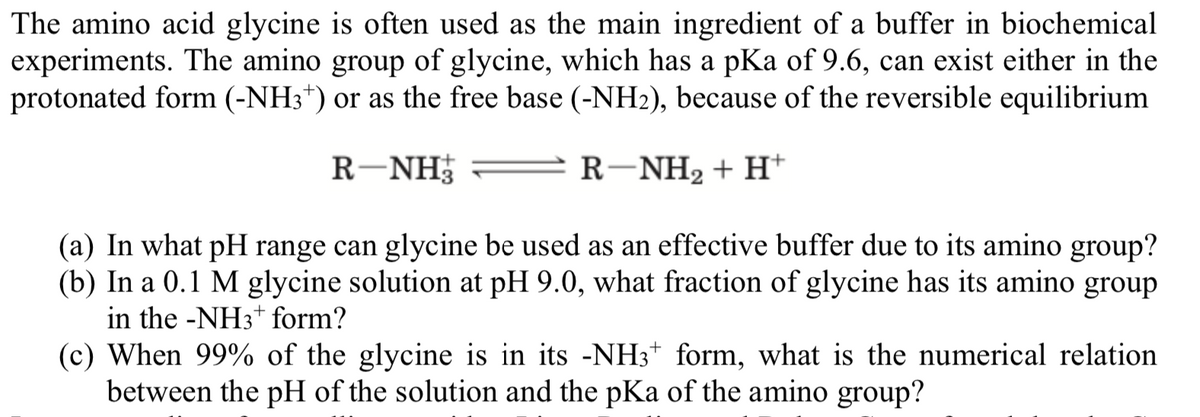The amino acid glycine is often used as the main ingredient of a buffer in biochemical experiments. The amino group of glycine, which has a pKa of 9.6, can exist either in the protonated form (-NH3*) or as the free base (-NH2), because of the reversible equilibrium R-NH =R-NH2+ H* (a) In what pH range can glycine be used as an effective buffer due to its amino group? (b) In a 0.1 M glycine solution at pH 9.0, what fraction of glycine has its amino group in the -NH3* form? (c) When 99% of the glycine is in its -NH3* form, what is the numerical relation between the pH of the solution and the pKa of the amino group?
The amino acid glycine is often used as the main ingredient of a buffer in biochemical experiments. The amino group of glycine, which has a pKa of 9.6, can exist either in the protonated form (-NH3*) or as the free base (-NH2), because of the reversible equilibrium R-NH =R-NH2+ H* (a) In what pH range can glycine be used as an effective buffer due to its amino group? (b) In a 0.1 M glycine solution at pH 9.0, what fraction of glycine has its amino group in the -NH3* form? (c) When 99% of the glycine is in its -NH3* form, what is the numerical relation between the pH of the solution and the pKa of the amino group?
Biochemistry
9th Edition
ISBN:9781319114671
Author:Lubert Stryer, Jeremy M. Berg, John L. Tymoczko, Gregory J. Gatto Jr.
Publisher:Lubert Stryer, Jeremy M. Berg, John L. Tymoczko, Gregory J. Gatto Jr.
Chapter1: Biochemistry: An Evolving Science
Section: Chapter Questions
Problem 1P
Related questions
Question
Please give a complete solution to the problem in the image. Thank you.

Transcribed Image Text:The amino acid glycine is often used as the main ingredient of a buffer in biochemical
experiments. The amino group of glycine, which has a pKa of 9.6, can exist either in the
protonated form (-NH3*) or as the free base (-NH2), because of the reversible equilibrium
R-NH
R-NH2 + H*
(a) In what pH range can glycine be used as an effective buffer due to its amino group?
(b) In a 0.1 M glycine solution at pH 9.0, what fraction of glycine has its amino group
in the -NH3+ form?
(c) When 99% of the glycine is in its -NH3+ form, what is the numerical relation
between the pH of the solution and the pKa of the amino group?
Expert Solution
This question has been solved!
Explore an expertly crafted, step-by-step solution for a thorough understanding of key concepts.
This is a popular solution!
Trending now
This is a popular solution!
Step by step
Solved in 4 steps

Recommended textbooks for you

Biochemistry
Biochemistry
ISBN:
9781319114671
Author:
Lubert Stryer, Jeremy M. Berg, John L. Tymoczko, Gregory J. Gatto Jr.
Publisher:
W. H. Freeman

Lehninger Principles of Biochemistry
Biochemistry
ISBN:
9781464126116
Author:
David L. Nelson, Michael M. Cox
Publisher:
W. H. Freeman

Fundamentals of Biochemistry: Life at the Molecul…
Biochemistry
ISBN:
9781118918401
Author:
Donald Voet, Judith G. Voet, Charlotte W. Pratt
Publisher:
WILEY

Biochemistry
Biochemistry
ISBN:
9781319114671
Author:
Lubert Stryer, Jeremy M. Berg, John L. Tymoczko, Gregory J. Gatto Jr.
Publisher:
W. H. Freeman

Lehninger Principles of Biochemistry
Biochemistry
ISBN:
9781464126116
Author:
David L. Nelson, Michael M. Cox
Publisher:
W. H. Freeman

Fundamentals of Biochemistry: Life at the Molecul…
Biochemistry
ISBN:
9781118918401
Author:
Donald Voet, Judith G. Voet, Charlotte W. Pratt
Publisher:
WILEY

Biochemistry
Biochemistry
ISBN:
9781305961135
Author:
Mary K. Campbell, Shawn O. Farrell, Owen M. McDougal
Publisher:
Cengage Learning

Biochemistry
Biochemistry
ISBN:
9781305577206
Author:
Reginald H. Garrett, Charles M. Grisham
Publisher:
Cengage Learning

Fundamentals of General, Organic, and Biological …
Biochemistry
ISBN:
9780134015187
Author:
John E. McMurry, David S. Ballantine, Carl A. Hoeger, Virginia E. Peterson
Publisher:
PEARSON